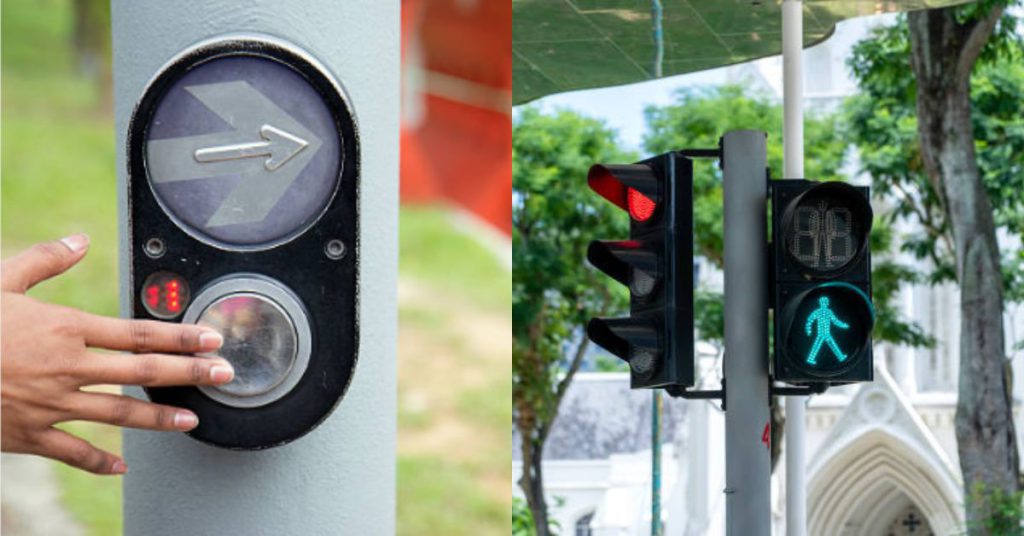Starting in the fourth quarter of 2025, pedestrians in Singapore will experience a more modern way to cross the street—by waving their hands instead of pressing buttons.
The Land Transport Authority (LTA) has announced plans to replace all mechanical pedestrian push buttons with touchless sensors by 2031, reported The Straits Times.
This initiative aims to improve hygiene and reduce touchpoints at traffic junctions across the city, where 11,500 push buttons are currently in use.
Here’s a breakdown of how this shift will happen and what it means.
Wave, don’t push
In place of the classic mechanical buttons that have been a staple at traffic crossings, touchless sensors will soon be installed. These sensors detect hand movements, allowing pedestrians to simply wave in front of the device to signal their intent to cross.
This upgrade won’t just make crossing the road easier but also more hygienic by reducing the need for physical contact, something especially relevant in our post-pandemic world.
LTA estimates it will take six years to complete the replacement of push buttons at roughly 2,790 traffic junctions islandwide, with work kicking off in late 2025.

How do the sensors work?
LTA trialled two types of sensors in 2022 and 2023: infrared sensors and microwave sensors.
After evaluating both options, LTA chose the microwave sensors for their superior performance in detecting hand movements across different weather conditions. Here’s how it works:
- Microwave sensors emit electromagnetic waves and detect changes in their frequency when a hand moves in front of them.
- Infrared sensors rely on changes in light, but these were found to be less reliable in certain conditions, which is why LTA opted for microwave technology.
The system emits a sound when it detects a hand wave, letting pedestrians know it has registered their request.
Less wear and tear
Another key benefit of these new touchless sensors is the reduction in wear and tear, which has been an issue with mechanical push buttons.
Pedestrians often press these buttons multiple times, which causes them to wear out faster. The new sensors, with fewer moving parts, are expected to last longer and require less maintenance.
Currently, mechanical push buttons have a lifespan of 15 to 20 years, but as they age, they need more frequent repairs.
With touchless sensors, LTA expects lower maintenance costs and less manpower required for upkeep. This shift will also contribute to fewer breakdowns due to improper use.
Ensuring accessibility for everyone
One of the primary concerns raised during the trials was how the touchless sensors would accommodate visually impaired pedestrians.
To address this, LTA has worked closely with the Singapore Association of the Visually Handicapped to develop accessible features for the new system. The inclusion of Braille and sound cues will help guide those with visual impairments through the crossing process.
The installation of the new sensors will be part of a larger contract for the maintenance and installation of traffic light systems in Singapore.
LTA has already called for tenders, with the submission deadline set for November 25 this year. The selected contractor will be responsible for submitting a design that prevents public misuse and ensures the sensors work well in all weather conditions.
Despite the new technology, the sensors will look similar to the current push buttons and will feature the same arrow plate to indicate the crossing direction.
Singapore’s shift to touchless pedestrian crossings follows similar moves in countries like Australia, the United States, and Canada, where hygiene and accessibility improvements have driven the adoption of these systems.
Mixed reactions from the public
Not everyone is excited about the switch to touchless technology. Some have expressed their reluctance to give up the trusty push buttons.
One person quipped, “We need that to relieve stress, as pressing can help to vent our frustrations in waiting too long for the traffic light.”
Another added, “Please don’t take this power away from us. I like being able to push furiously for the system to understand that the red man has appeared for too long.”
Others, however, are welcoming the change, especially given how sensors have become more common in places like elevators and access doors.
“It’s a very good idea to have touchless sensors, but the button should remain there as a backup in case the sensor is faulty,” one individual suggested.
Featured Image Credit: iStock

